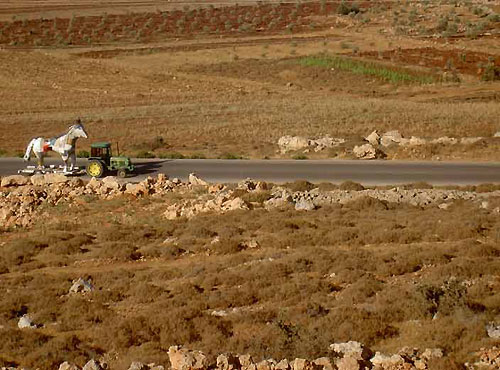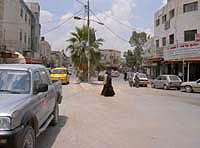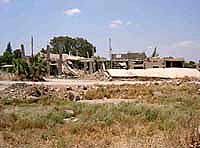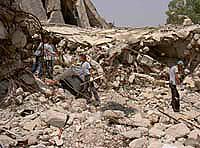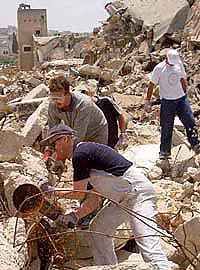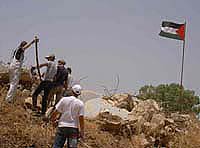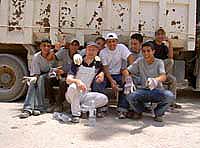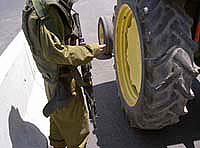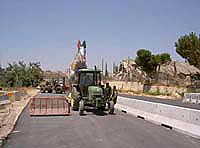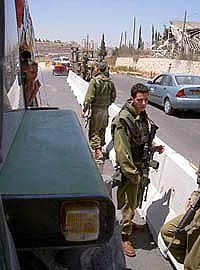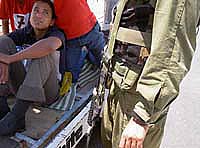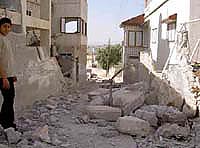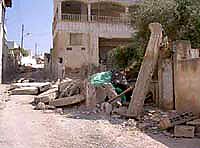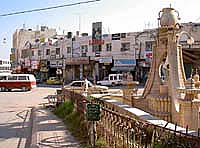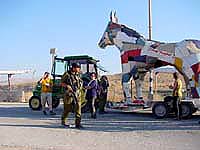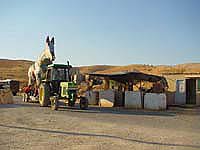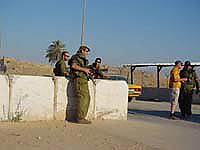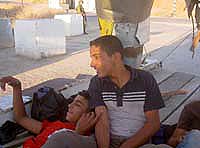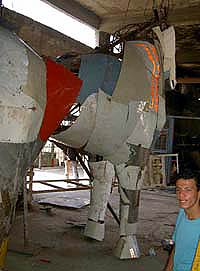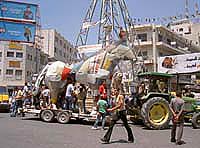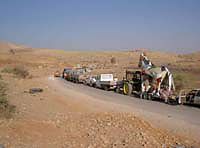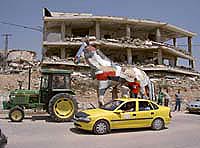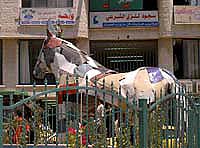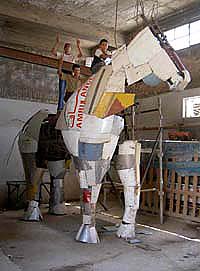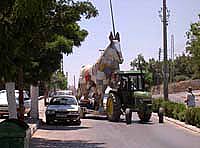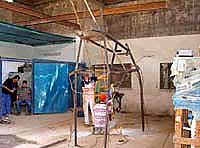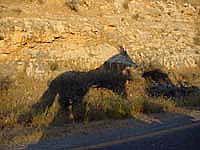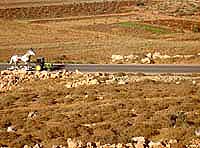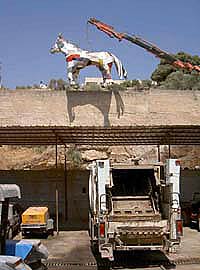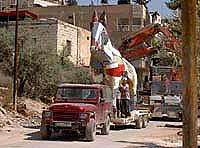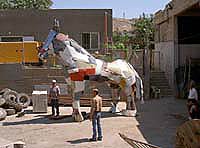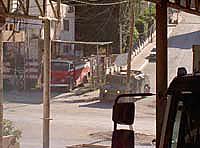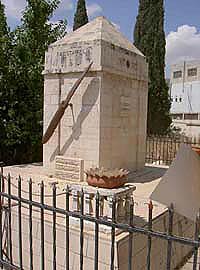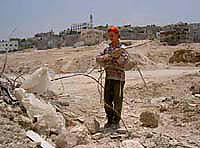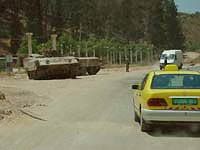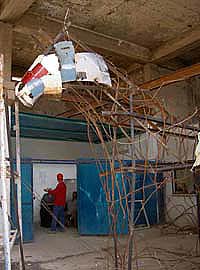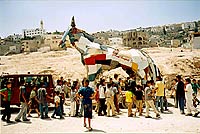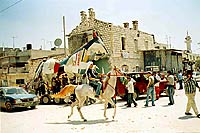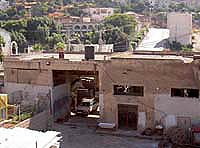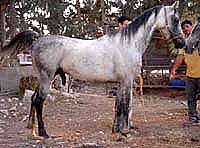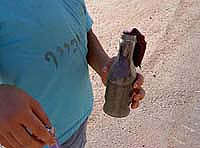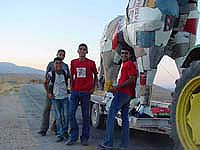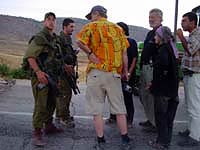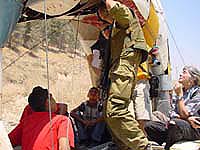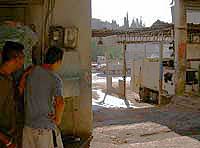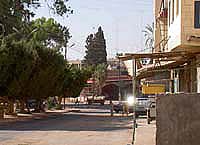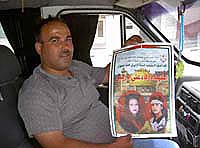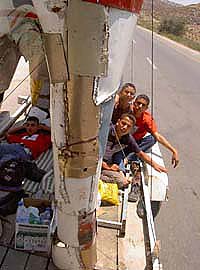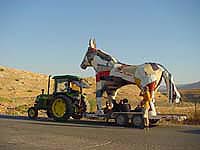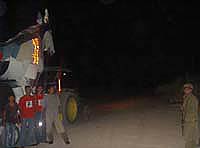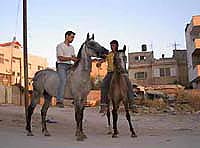part of the exhibition “Kirchner Holzschnitte – Benjamin Badock, Gabriela Jolowicz und Thomas Kilpper” @ Kunsthalle Bremen

the exhibition runs through March 9, 2025 –
part of the exhibition “Kirchner Holzschnitte – Benjamin Badock, Gabriela Jolowicz und Thomas Kilpper” @ Kunsthalle Bremen

the exhibition runs through March 9, 2025 –
Museo Marino Marini, Villa Romana and déjà.vu present
THOMAS KILPPER
Learning from the Maghreb. How to get rid of unwanted presidents?
featuring Emanuela Ascari, Astrid Auberger, Giulia Cenci, Eva Geatti, Maria Gleu, Ozan Erme Han, Cemile Kaptan, Daniela Spagna Musso, Alia Scalvini, Dominique Vaccaro, Eugenia Vanni, Johannes Wagenknecht. Curated by Lelio Aiello —— 30.06.2011, 6:30 p.m.
In June the artist Thomas Kilpper (Germany) held a workshop titled Learning from Maghreb. How to Get Rid of Unloved Presidents? in Villa Romana, Florence. In line with the past years’ experiences, the work.lab has focused the attention on everyday life and its territorial, social and political implications. It has asked questions about the role of the artist in society and how to address social issues through art. For whom do we produce art? Which is the role of art in the struggle for social emancipation and equality? Could artistic and aesthetic strategies be developed for social change?
The workshop has involved twelve participants in the realization of an artwork in the entrance area of Museo Marino Marini, for which recycled materials were used. The installation was elaborated within the limits of sculpture and architecture through the active participation of the group.
The twelve participants were selected by the committee formed by Lelio Aiello (work.lab curator), Angelika Stepken (Villa Romana Director), Alberto Salvadori (Marino Marini Museum Director), Thomas Kilpper (artist).
work.lab is part of déjà.vu, a project born in Bologna, that has pursued for four years a study that includes internationally renowned artists, students, and public places in a dimension of dialogue and participation.
Villa Romana is a structure founded in Florence in 1905 by German artist Max Klinger which acts as a forum for contemporary art that favors, through exhibitions and various initiatives, a fruitful dialogue with the local reality, and promotes cooperative relationships with interesting partners. Each year it establishes an international award for artists offering a residence for one year.
The Marino Marini Museum is a Foundation that ensures the conservation, the protection, the development and the exposure of Marino Marini’s works to public, and to manage the Museum situated in San Pancrazio’s former church, in Florence. It promotes cultural events and exhibitions dedicated to artists and themes from the twentieth century to the contemporary.
aritmia is a cultural association based in Bologna that promotes artistic experimentation and production most adherent to the contemporary culture.

Thomas Kilpper
Revolutionary Free Speech – a workshop with lectures and performances on the occasion of Speech Matters, a group exhibition curated by Katerina Gregos in the Danish Pavilion at the 54th International Art Exhibition – la Biennale di Venezia
Friday, June 24
| 2:00 – 3:00 pm | Regina Wamper | „Beyond Freedom of Speech“ |
| 3:20 – 5:10 pm | Jakob Jakobsen | „The Cultural Battle in Denmark since 2001“ |
| 4:40 – 5:10 pm | (salong) | noise performance with young artists and students of the Academy of Fine Arts, Munich |
| 5:30 – 6:00 pm | ReBiennale | „Beyond the Venice Biennale“ – social and environmental activities in Venice. Afterwards there will be food and a party at the social centre „El Morion“ in Calle del Morion, which is run by the ReBiennale network |
Saturday, June 25
| 11:30 am – 12:30 pm | Gáspár M. Tamás | „Beyond Revolution“ |
| 2:00 – 3:00 pm | Salah Methnani | „Beyond Migration“ – The anger of the Maghreb and Arabworld, To what extend belongs „Freedom of speech“ and the „freedom to move“ together…? |
| 4:00 – 4:30 pm | Thomas Kilpper | gives a tour in his work |
| 5:00 – 5:30 pm | (salong) | – noise performance with young artists and students of the Accademy of Fine Arts, Munich |
A invitation to a live concert
Thursday July 9, 2009,
from 8 pm
Former Ministry for State Security of the GDR
Normannenstraße 19 – 10365 Berlin-Lichtenberg
Erste Stufe Haifisch – Katrin Plavcak, Rudi Fischerlehner, Bihn and R. Ockstroh – from Berlin
Victim – Pub Fight, Car Crash & Iron Fist – from London

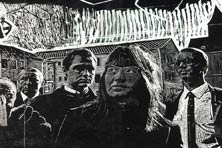
Tuesday, July 16, 5pm – Meetingpoint: Entrance to the Exhibition “State of Control“, former Ministry of State Security, Normannenstr.19, 10365 Berlin-Lichtenberg.
We will first visit the Stasi-Museum next door and subsequently have a guided tour with Thomas Kilpper (artist) and Sophie Goltz (head of communications at n.b.k.) through the exhibition State of Control.
State of Control – Out of Control – (Arbeitstitel)
In Normannenstraße 19 – a building of the former Ministry of State Security – an oversized ‘linoleum cut’ will be made in the floor covering; 800 m2 PVC floor covering will be the starting material.
I cut into the found substance of this charged place in order to ‘appropriate’ it. Images emerge from the context of ‘state surveillance and strategies to counter it’. I inscribe them in this place and thus transform its ‘base’ – the ground – into a stamp. A controversial, abandoned place in contemporary history is reoccupied, revived and redefined.

PVC-flooring – Normannenstraße 19 – Stasi-HQ – Berlin
Tuesday 18
At 4.30pm Andrea Sassi the director of dispari&dispari project and I leave Reggio Emilia and drive to the Airport of Parma.
We have booked Parma to Palermo. Queing up for the saftey check before boarding… the loudspeakers call “Mr. Andrea Sassi…please come to the luggage-control office…” oh oh, I think we get a problem… – in our luggage is one electrical and one petrol run chain-saw…. Andrea goes there while my hand-luggage get controlled more than intensively. My tripod does not go through; how naïve am I – of course it’s a potential weapon! Bringing it to my car is too late… so one policeman kindly organizes to get the closed check-in reopened and one more luggage-ticket.
Andrea arrives – he manages to make the police-officer say, “generously and exceptionally we do not halt your chain-saw”…
In Palermo superstress, even our plane arrives 10 minutes ahead schedule, we have only 5 minutes, as we booked two different flights and have to check-in (Palermo – Lampedusa) once more. We decide that Andrea goes directly to the check-in and only I wait for our luggage. When he arrives at the check-in desk, it was already closed! At the same time at the buggage belt when the first suitcases arrive I realize its really difficult to recognize someone else’s suitcase. They all look the same… but I was lucky to grab the right one – a quick look inside helped to make it clear.
Running upstairs as fast as I can… Andrea calls me, “Thomas where are you, hurry up!”… In the meantime he has gone to the office of the airline and manged that they reopened the check-in desk… They take our luggage and we run to the departure, passing the saftey control and boarding immediately. Puh, this was very tight.
Now a small propeller aircraft with about 30 passengers takes us. It flys quite nervously compared to the lethargic Airbus. At 10pm we arrive in Lampedusa. Maria’s sons pick us up at the airport and bring us to our appartment. The same house like during my first stay – but one more room was open and prepared for us. It’s different – this time I return, everything seems familiar and aquainted. After a pizza we go to bed – totally tired.
Wednesday, 19
After a quick breakfast-shopping and coffee, we go to the townhall. I say ‘hello’ to Marco, last time my interpretor – together we go to the major’s office, but he is not in. He is supposed to be here at 1 o’clock… So we get photocopies of the appeal and the invitation for our Friday evening meeting about the lighthouse project. From Berlin – some days ago – I had called Antonino from Radio Delta, since than he has organized this meeting. Really super! At Edo’s Noleggio we rent a scooter and a bike. ‘What are you doing here again?’… After a little chat and handing over the freshly copied appeal and invitation Edo’s wife Michela tells us, that she has a job in the refugee centre. She suggests to put us in touch with the anthropologist who works in the centre, too. Sounds very interesting. Andrea leaves his mobile number and we agree to stay in contact. We do a little tour with the scooter – to the boat cemetry, where some twelve new boats have been delivered since I was here, seven weeks ago.
Boat-Cemetry Lampedusa, 2008
Making contact with the depot’s staff members… some recognize me…Then we cross half the island down to the Istmo dei Conigli (Isle of Rabbits): Whow! What a stunning beach! White sand and the clearest and purest seawater I have ever seen.
Istmo dei Conigli (Isle of Rabbits), Lampedusa, October 2008
At 1pm we are back to the major’s office, but he is busy with another meeting. We are told to come back half an hour later, but we prefer to wait. Ten minutes later the major, Bernardino De Rubeis leaves the meeting and comes to us to sit down in front of us.
Andrea explains our request, that we already had expressed, that we need his authorisation in writing to split and take some of the refugee boats on a big truck to Reggio. Mr De Rubeis calls the director of the waste depot that we already have met in the morning. He doesn’t have any objections to our plan and instructs his assistant to set up a letter of authorisation. Half an hour later we have got it.
Off we go!
Preparations start, buying a petrol can, the petrol itself, gloves and we need extention lead for the electrical tools… Antonino – accompanied by his friend Nicholas – from Radio Delta and Alternativa Giovani comes to the waste depot. Great to see him again. He organizes the extention cables that we have to fix with each other – otherwise they loose connection: tape! We are badly organised, but the circumstances are difficult. What boat shall we take, shall we both work on the same, shall we do documentation, video, photos…? We choose one – that looks still relatively nice and is laying close to the entrance gate and office, where we get electricity. The sound of Andrea’s chainsaw is amazing. It immidiately suggests heavy labour is underway.
We do some ten – fifteen cuts – mostly in the direction against the boards, trying to avoid to hit the nails.
cutting the refugees’ boats
When we have to finish because of the darkness our results are meagre. Tomorrow we have to start early in the morning and do the cuts more systematically.
Andrea receives a phonecall of Michela who works in the refugee centre: tomorrow at 11am we can meet with the director of the CPT.
Thursday, 20
I wake up at 6.30 (for me very early), do a fruit breakfast, knocking up Andrea at 7.30. I join him to the bar for a quick coffee – at 9 everything is prepared and the chains are rattling. But today we have to cut in the other direction, where the chance to hit a nail is much bigger. Underneeth relatively soft floor planks are the beams that carry the weight and absorbe the power of the waves. They are the very core of the boats’ construction – and made from incredibly hard wood. And here I hit the nails. You cannot avoid as you can not see where they are. Promtley the chain is killed and smoke rather chippings arises. Definitely my day of disillusion. I get the feeling to fail. Shippwrecking with shipp-splitting?
Shortly before 11am we stop cutting – Andrea and I – briefly meet with Michela and Federico x, the director of the Lampedusa refugee centre – in front of the entrance gate. When he appears I first think: ‘this is not the centre’s director…‘ but obviously he is. thirty-something, long hairs, sportif, casual wear, bad teeth. I would like to address some questions… but he insists: “I can’t talk to you, as I don’t have any authorisation…”, “but why do we meet at all if you can not talk to me?”, my question fundamentally questions this meeting what everybody seems to understand; Federico changes his attitude: he now explains what we have to do: “write a fax with your personal details… to the Prefettura in Agrigento and ask for permission to visit the refuge centre and to do an interview with the directorate / me…” noting the fax-number on a piece of paper and leaving the scene quickly after.
Michela offers that we can send the fax from her husbands moto-rental workshop. So we drive to Edo’s ‘Noleggio’ – set up a letter first in English, Andrea translates it into Italian. An hours later the fax goes through – pigs must fly to get permission by tomorrow. But we have nothing to loose.
Andrea and I we go back to the ships and continue our work – but again the results are devastating and frustrating. Not easy to admit, but my time is too short, my means to little to get the plan carried out. I think I must give in and change the whole concept how to present the project in Reggio Emilia. To build an adequate model, walkable in its interior… in Andreas 300sqm space with nine meter ceiling… I’d need not just 15, 20 pieces (one sqm each) but at least some 100 or even 200 – otherwise its looking redicoulus.
Is it embarrassing – first to ask for permission and than to fail? And what about the company of the transport? We have to call them and cancel the job. Otherwise we have to pay! That means: we must decide now!
“we cannot succeed… the boats are densly nailed. These nails kill our chain saws…“, explaining the situation to Antonino and Nicholas who again came to the waste depot: they are quite disappointed and take it serious… what I like.
“It would be so great if you could build a tower from these boats… if you can’t do it now you must do it later in Lampedusa itself!” I agree and promise to try at a later stage – but for the time being – within our tight schedule – the boats are ‘stronger’ than we and our means.
That failure looks like a metaphor for the refugee problem as a whole: its bigger and more serious than expected. Dealing so directly and closely with the African boats I get a sense how much power is involved in the process of migration.
from authorities damaged refugee boat, Lampedusa harbor, 2008
For African fishermen the boats must be of big value. They are not designed for crossing the sea – but going out for fishing some miles offshore they seem well functioning and totally worthwhile.
Andrea calls the transport company but can’t get hold of anyone – he leaves a message “sorry, but we have to cancel our transport to Reggio Emilia…”, they don’t call back.
From now on we take photos from the boats and the boat cemetry as a whole – more systematically. If I can’t build the tower with the real boats I want to have the option at least to use photos of them in one way or the other. Building a tower with a large-sized collage of photos?… it’s totally open how my installation will be built and look like in 2 weeks time…
In the later afternoon Andrea and Antonino go for a swim – I prepare my slide-talk and the meeting tomorrow…
Friday, 21
At 10am I call the Prefettura in Agrigent. First attempt: the operator hangs up when he get aware that I ask for permission to visit the refuge camp in Lampedusa. Second attempt: he does not react nor put me through to the right officer until Andrea takes over the phone: “You will get the official decicion within ten days…”. “Sorry, but we’ll leave Lampedusa already after tomorrow, on Sunday”, Andrea explains very friendly. There is little hope to get permission; the reason seems because I am not a journalist.
In the afternoon we collect our belongings, tools etc… at the waste depot.
In the evening – at about 6pm – Andrea receives a phonecall from the prefettura in Agrigent! Friday evening, I never received any phone call from public authorities, but here in Sicilly they are still at work: they are about to release the permission for my visit in the refuge camp! What a surprise! And they need my date and town of birth… Wowh! Nobody expected anything like that: the next day I will be able to enter and visit the camp!
Interviewing the camps’ director, yes! – But…: no permission to talk to or even contact the migrants! That’s dull and very strange. Why that? … It’s said “to their own protection”? As if they could not express themselves if they don’t want to be interviewed. Somehow this shows their status: they are in custody and under state supervision, like a prisoner.
The meeting and my talk goes well. Twelve interested Lampedusians come; unfortunatelly only men – but the interpreter, she is an English-teacher. A film maker, two journalists, radio maker, students… even the pastor came with an African colleague. I show photos of previous projects and give a short introduction to my work – and as well to the lighthouse project. It is a very nice and constructive athmosphere.
Saturday, 22
Andrea drives the scooter and I – just sitting on my bike – holding his right arm, get pulled… what a nice way to move. shortly before 11am, we are waiting at the entrance gate of the refugee camp for the director and to get in… After a while it is clear: Andrea can’t enter, because we did not mention his name when we asked for permission on the fax to the prefettura… We try to convince the officers, “Can you not turn a blind eye on that, Andrea could be my interpretor…?” but they stick to their regulations. Only I can go in…
At first the police officers say: “no photo, no video…”, but the head-administrator of the camp, who is my supervisor intervenes: “panorama shots yes, portraits not”. He stays closely next to me, keen that I do not go beyond this “red-line”… but the longer we are in the camp, the more relaxed he gets.
Already at the entrance gate you can get a feeling that the camp is very full and crowded. It’s now shortly before lunch-time and the inmates are waiting outdoor in the courtyard and queuing for their meal.
Lampedusa Refugee Camp, November 2008
Francesca the camps interpretor (she speaks Arabic, French, English and Italian…) explains the structure of the camp. A so called “pre-identification” is the first thing in the camp the migrants have to undergo. Most of them arrive without official papers or ID, they are asked about their name, country of origine, date of birth and get an internal registry number. This procedure is followed by a health check with medical assistance and doctors from the camp. After that civil employees from the camp are handing out the so called “kit”. The “kit” comprises all clothes needed: a jacket, trousers, a shirt, underwear, socks, shoes… and a 5€ telephone card. So the migrants are able to call their families or friends for one or two minutes…
phoning @ Lampedusa Refugee Camp, November 2008
The Lampedusa camp is a closed off area. The migrants are not allowed to leave it. They are supposed to stay here for only a couple of days to make place for new arrivals. But in reality most of the inmates must hold out for a couple of weeks if not months because the other refugee- camps and CPTs in Sicilly and Italy are full, too or the Government not willing to take the Lampedusa-migrants. Therefore the Lampedusa camp often is heavily overcrowded. The same is now: in the men’s compartment the yard’s floor is widely covered with mattresses. They are without blankets – some inmates have tinkered a makeshift coverage as sort of a ‘roof’ from taped plastic bags, fixed from the camps metal fence to the bottom of their mattress. Coming from Africa to Europe = sleeping rough – even in November!
Lampedusa Refugee Camp, Makeshift Outdoor-Bed @ Men’s Compartment, 2008
We get asked for cigarettes or a lighter… they are welcoming Francesca; she is one of few from the camps administration they can talk and communicate in their language.
One migrant tells of his crossings experience, where three others have been perished drowning in the sea. Two in Africa when they had to swim to the boat – one when they arrived at the shores in Lampedusa… But that is the only short opportunity to talk to one of the refugees, when the inspector goes into the building to check the medical department (if we can go in or if there are patients who could be embarrassed about our visit). Francesca, the interpretor helps translating. I wished to be able to do more interviews with the immigrants. But no way…
In the medical department a couple of GPs and family doctors are engaged – but no specialists, even not a dentist. The administration seems to be proud of the modern kitchen with its conveyor belt and automatic production line.
When we are finished to walk and see the camp and the interview with Federico, the director is due, I learn that it can not take place! He is busy. Strange enough, that was the reason they suggested me to come here. Okay, lets try later in the afternoon.
Cycling back to our flat, I somehow feel stired up from what I have seen in the camp. They are living so cramped, why can they not leave the camp…?
In the afternoon we call Federico to do the interview but again, he is busy. “let’s do it tomorrow” he suggests. Is he willing to do it at all?
At 5pm we meet at Radio Delta’s office. The only local radio station on the island. It’s small but Lampedusians are listening to it. Antonino is doing a one hours live-programme on air with Andrea and me about the lighthouse project! Starting it off with Pink Floyds “WALL… we don’t need no education”, I have the opportunity to tell them how I developed the idea and how it might be realized in the future… We have good fun in the studio. Andrea translates into Italian what I say and he speaks from his perspective as a gallerist. Antonino is great, well organized, hard and fast engaged in social issues of the island, great fun to get to know him. He really wants to push the project on Lampedusa: “Why are you doing a modell for the lighthouse in Reggio Emilia… you should do it here, here is the place it has to stand…” he said on air.
Later we are going for a nice dinner together. Tomorrow we have to leave. In forteen days the exhibition opens at Andrea’s gallery!
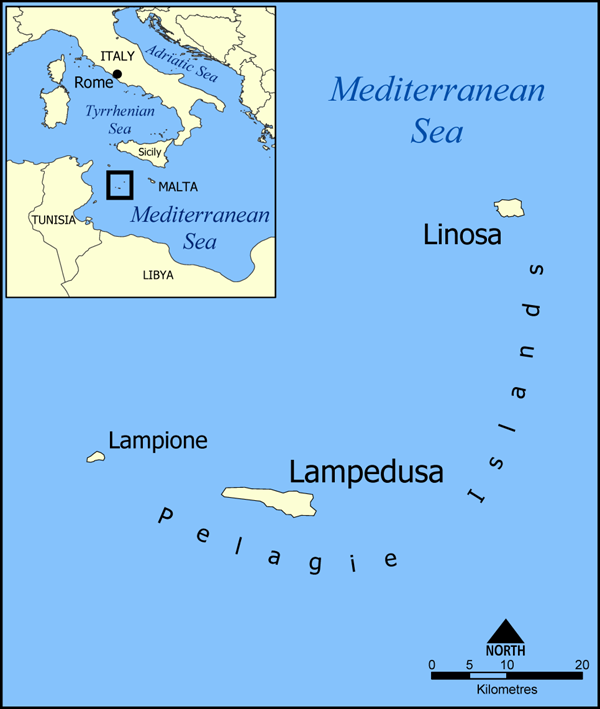
September 29, 2008
Flight: Berlin-Milano-Palermo-Lampedusa
Checked in at Berlin-Tegel, reading the Frankfurter Allgemeine Zeitung, loudspeakers shout: “last call for passenger thomas kilpper…” I run to the gate, discover that my boarding-pass and ID are missing, running back to the table where I was sitting… lucky me: my jacket with all the money, ID and stuff… is still there. I am the last passenger to board the plane.
Arrival in Lampedusa at about 9.30pm – about an hour in delay: tourist-photo-shots from the gangway, …“no foto” says the officer – stick to it: no more flash but video: on the way to the exit we pass an african plane that some four, five Africans are just about to board – a guard standing next to the gangway. Obviously a deportation flight.
Weather is nice, mild and warm. I inform Maria about my arrival, ten minutes later I am sitting in her car on the way to my – better: her appartment, off Via Roma. It’s very central, big and quite ideal for me.
Going out for a pizza – I come across a mourning procession, some 50-80 mourners silently follow an old mercedes catafalque that stopps in front of the church, next to a black priest. Nice images, pity I left my cameras in the flat: never go out without ‘em here! I wonder… why do they have a black reverend – here with the african refugees…? I should try to meet with him!
After lunch watching Italian TV, a Vietnam movie – in the style of Stanley Kubrick’s full metall jacket but much weaker. A small group of US-soldiers kidnap a young Vietnamese woman into the woods and rape her – only one of them resists and wants to help her; but he is too weak, to stand up to/against his comrades to stop them. “victims of the war” channel 4.
In the night – must have been in the morning at about 8am – I dreamt intensively crazy stuff, my sister flooded entirely our large bathroom opening the water-pipe to the toilette. When I came to our house everything was watered, even from the neighbours ceiling it was dripping…
A funeral’s procession – rape – flooding… what a start.
Tuesday, September 30
Sleeping late, shopping in the supermercado, breakfast. Prices are fairly high – summs up to 43.60€… giving a 50€ note, becoming 10€ back, with a generous and determinated gesture. Never experienced anything similar in Germany. Islanders…?
Rain. Somehow desoriented I’m roaming in the centre of the town, watching the streets, the houses and public life… looking for a bicycle to rent, looking for the townhall… asking for the councilor for culture… “Antonio Colapinto has just the council…” it seems a new councilor for culture still has to be appointed or voted…? “Tomorrow at ten, the major is here…”.
I ring the reverend’s bell, nothing happens, not at home…
A bike rental asks for 10€ per day… – though I got a scooter offered for 12, and meet a couple with bikes that cost a fiver each per day. But there all the bikes are rented out, so I wait but take a scooter for one day asking the guy he shall send me a SMS once a bike is available.
Scooter is great, really fast, I search the office of “Alternativa Giovanni ONLUS” at Via Grecale 22, find the address and someone in an office on the ground-floor in that very building and ask him about this group… “where are they…?”, “I don’t know, but not here; I think they are somewhere in the centre…”. When I am about to leave the building I discover the group’s logo on the first floor and a sticker next to the staircase. Asking him about that… he was slightly irritated…, “well they are on the first floor… (primero piano)…” – I don’t know what that was, as he works here everyday?
Driving my moped – I reach in 15 minutes the end of the isle passing stoney fields with wild herbs making the air smell oregano. The cliffs are massive and steep to the north coast, beautiful, clear azure blue water, an empty quarry, military radars and antennae. The drizzle now turns into heavy rain, I look for some protection in the quarry, when the rain decreases I go to the moped to return, large and deep slops make me drive slow, as heavy rain starts again I just drive in an open private ground with a garage. After some 15-20 minutes I continue my way back… completely wet and watered.
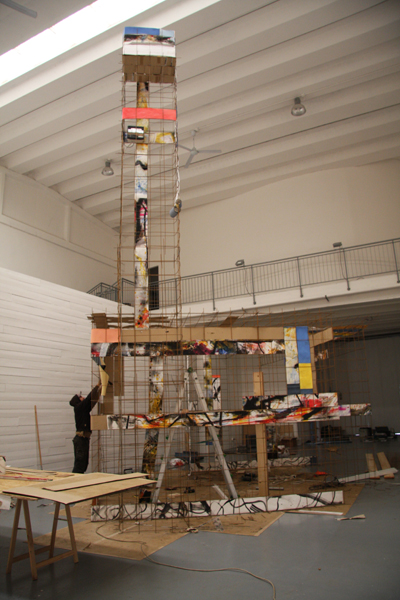
Wednesday, October 1st
The day of waiting. At the townhall (municipio) – 2nd floor, here are the offices of the major and the councillors. People just go in and out, no queuing or anything similar… I am told just to wait, what I patiently do for about 90 minutes. Somehow interesting to be here and watch. It reminds me to Jenin townhall – but the big difference: there I had my projects partners from the Goethe and a local scout at my side. But the way people behave and move within the townhall to contact the major or other officials is quite similar. It seems everything is to do with subjective relationship. After 90 minutes an employee of the commune led me to Marco Bartolo – an employee on the first floor – who speaks English and shall come to help translating. First he is not happy about it at all as he would have so much to do. But after a while talking to me – he turns quite open and friendly.
During waiting an elderly, about 70 years old, ordery man roams the 2nd floor, behaving as if he is in charge,… curious what I am about… I show him and the bystanders my project proposal, (that in the meanwhile I received from Andrea Sassi and printed it out in the only public internet-point on the isle) he turns quite openly negative: “we have already a light-house”, “who is your employer or principal, you have to present them here and to write a concrete letter of request…” pushing me to defend the project: “of course you have a light-house… but it is not an art-work – and I am the artist and as such I am my own employer and boss – like Michelangelo was, when he made his David…”. He tries to persuade the employed – in Italian – they should not listen to me, it would be rubish and obsolete – obviously believing I would not understand. I later learn he was an ambassador and now lives part-time in Lampedusa. Marco openly says “he’s an a…” – he will know why.
After almost 2 hours a high-heeled shaky beauty comes and let me know: “Tomorrow at 10am the major will be here, come then once more…”
Now I want to find the boat-cemetry, artist Marco Poloni has told about when we met in Berlin. Easy to find. It looks quite surreal and impressive – a bright blue dot in the middle of the fields.
Actually there are two boat-dumps, one next to the main road, and another one some 300 meter further down the valley, the municipal waste deposal site, for cars, fridges, sofas… and the boats of the immigrants. Partly piled up like sardines in a box partly piled up criss-cross – they seemed to be painted with the same paint as they have almost an identical bright blue tone, most of them have arabic names at the bow. That’s the material for the sculpture – at least for the model in Reggio Emilia and Florence. Should be possible to get some of em, as shredding and removal for the commune only costs money. Most important discovery on the island until now. From now the idea to buy timber and build the model with it seems not convincing anymore. How do we get and transport them? Will shipping be expensive…? I have to divide the boats fitting on a lorry (needs a loader crane) – or would it be better to ship them on the sea to La Spezia. Forgot to ask for the telephone number of the waste depot…
Next… to the lighthouse at the northern end of the isle. It’s in military use (nameplate at the gate), the tower is about 12-15 meter high, wonder how far can it be seen? The cliffs are some 30 meter deep, if not more, it’s postcard idyll. Next to the tower is a climate research observatory.
On the way back to town I pass and stop at “Alternativa Giovanni”, leave a note with my phone number at the door.
Return my lovely moped and change it for a lousy mountain-bike instead, rattling, wobbly, the gears are not working so I have to go back and try to improve it with the mechanics…
Discovering the only Gallery in Lampedusa – “LMP Art Gallery”… increddible kitschy prints, but as well nice old black&white photos from Lampedusa. A photo with Mimmo Paladinos Lampedusa-Refugee-Monument “Porta di Europa” on display makes me ask, if he has any contact to the people who supported the monument.
He gives me the telephone number of Giovanni Fragapane, a local writer and artist. Calling him turns rather in a choking word finding than conversation… but at least we manage to arrange an appointment at 3pm at his house. Via Roma 133, less than 100 meter from my flat… with our cell phones we communicate via satelites over a distance of about 10.000 miles…
On my way home from lunch in a nice restaurant I bump into a wonderful public music and dance party – sweltry tear jerkers at piazza Brignone.
Do some videoing and shots. The dramatic migration problem as background for my journey I arrive in this very party. Haven’t seen a single refugee, none – they are an invisible phantom. Where are they? After my first information, the detention centre would be next to the airport, I do a walk-through there, discovering a construction-site with lots of surveillance cameras. It might be part of the deportation procedure but the real detention centre – called CPT (Centri di Permanenza Temporanea / centre of temporary stay/detention – permanent temporary seems antagonistic… doesn’t it?) – is located in the centre of the isle, placed at the end of a small valley, into which you have to go for about one km (on Via Imbriacola), to arrive at the entrance gate.





Thursday, 10 am – municipio
The major is present, listens just three sentences to jump up from his chair “…che bello… un progetto d’arte… un faro con centro cultura… d’ architetto Renzo Piano…” rushing to the anteroom and handing over the issue to Mr. Gianni Sparma, councilor for tourism, transport, sport and spectacle – as they actually do not have any for cultural affairs.
Great, Marco translates. Mr Sparma is very formal, “we need a precise description and application of what you want …”, “…At this stage, we just need from you the permission to take some four, five boats from the communal waste depot to build my model in the exhibitions in Reggio Emilia and Florence.
Asked to repeat this in front of my camera, for a second he turns sympathetic as he shyly smiles obviously irritated – “shall I feel flattered? or…”. Backdrop during the interview are awful propgandistic illustrations. They truly remind me to the ‘style’ of the Third Reich – they are the cover-pages of the annual reports 2006 and 2007 of the ‘Guardia di Finanza’. Horrible but it clearly shows where we are. Glaring.
After the meeting I write the demanded letter and send it (in English) to Andrea for translation… would be great to present it to Mr. Sparma the next morning.
At 3pm I meet Giovanni Fragapane. Very nice and sympathetic – communication in Italian with some French and English nuggets – quite difficult – but easier than on the phone, as we can watch our gestures. He talks slow and articulate, tries to make me understand. He likes the idea with the light-house but obviously not the use of the refugee boats. That would cause some sanitary and hygienic problems – the purity of the project would suffer – do I understand well? why that? what does he really mean?
I am a bit confused and definetly think different about it. We watch the road atlas of Sicilly and get useful tips and telephone numbers for my trip there. Definitely better to take the plane to Palermo (spending some days in Sicilly…) than the ferry boat to Porto Empedocle, as in case of bad weather, the boat is not running (missing my plane from Palermo to Berlin October 8…)
Nice meeting – but trying to get in touch with any supporter of Mimmo Paladinos Monument…: no way. (I still don’t know how this sculpture was developed and installed but there must have been a group of supporters it can’t have been only the initiative of the artist. The ‘appello’ is peppered with famous Italians.
Take my bike and cycle to the office of the ‘Alternative Giovani’, have a look if anyone is there… – lucky me, this time I meet Giacomo, who confirmed my note at the door, he calls his friend to come as he speaks English. Antonino arrives 15 minutes later and I tell them the idea – what they very much appreciate. They seem to be really enthusiastic and want to see more work – so we switch on their computer and browse my web-site… Giacomo: “crazy artist… – …utopist…”. This sounds not bad to me. Giacomo has to leave for his job in a hotel – so we disperse not without the promise to meet again soon and stay in touch. Nice guys, quite young – I guess 18, 20 something… but not much older? I’d fancy working together with them.
Where exactly is the CPT? – Giacomo made a ballpen mark on the map. But as it was fairly incorrect my search for it took about half an hour. In fact it’s hidden – they placed it at the end of a valley. In the darkening sky an extreme bright light at the end of the road betrayed it. Arriving the entrance gate shortly before 8pm – three men sitting in their car, the engine running… I try to gain some seconds and go aside for a pee but cannot really hide and wait,
there is nothing but some parked cars and they already have seen me…, “I bet they are guards, waiting for a colleague” – my thought is quicker confirmed as born…, of course they can see my camera… “you are not allowed to take any footage, it is a military object – you need to ask for permission at the police-station, yes… even from outside”, I let my camera running, the lense ostentatiously directed to the ground – I hope to have our exchange of words taped and that the sound is utilisable. But no images so far, I need some ideas on that!
Buy a (devil-?) fish and a squid at the nearby harbour – capers, olives, lemon and origan – nice cooking, drawing with the squid’s ink a small sheet – “poor calamari”, tomorrow the other devil gets grilled. Tastes super, I love calamares.
Friday, October 3
At 10am at the never friendly L’EDICOLA – kiosk the only Internet-Point here: Andrea has sent his translation – superb! – we speak on the phone: his suggestion to drop one line for the time being (the light-house shall help minimizing the risk during the perilous crossing) and to bring this when the project is approved… is ok as we need the municipio… the project cannot go ahead without – and it’s run by Lega Norte!
Bring my letter to Mr. Sparma, he criticises the partly general character – I point out: not all things can get finalised at this early stage of the project but that our request for permission to take 4, 5 wrecks is precisely formulated. “Who will decide it?…”
“Probably the prefetura di Agrigento – as it is the superior authority…” – “You can’t decide independently on your local waste dump…?”
Sounds like disillusioning administration-gaga. “How long will it take you to come forward with a decission…” – “at least one month…”, aha, I see (how similar cases seem to be, Frankfurt jail, Frankfurt savings bank 1822, Queen Mary College, German Railway with the Stasi-HQ… – do I anything wrong?) – he stamps and registers our letter: “PROT.N: 12297, RICEVUTA 3/10/08.” Assoluto ufficiale – absolutely official.
Cycling once more to the boat-cemetery and waste-depot, talking to the man at the gate, somehow preparing him, and would have been good to have his telephone number… “here we don’t have”… “and what about your cell-phone?…”, don’t get his number. Leave the scene and at the end of the site where the fence has a gap I sneak in – take out a plank with partly arab signs.
It sticks out of my rucksack so I decide to deposit it nearby under a little tree. I don’t want to attract attention as I will try to approach the detention centre. This time from the other end.
Passing the waste-dump and following the street, that soon becomes a stoney path – some fivehundred meters later it leads into the street that brings you to the prison’s entrance gate… The people and their former boats are not far away from each other. By accident?
I would like to come close to the CPT and try to talk to the inmates, how are you, how was your crossing, how long did it take, what do you expect in your case, deportation or will you get access to europe and the status of a refugee…?
I try to approach the site from south, you have to find the right access, with public paths that do not turn into dead ends… After all I manage to come as close as 300, 200 meter. Am I crazy? Just now a low flying helicopter approaches (in approximately 100m hight); directly above me! Hell, it’s the first time I hear and see a helicopter in Lampedusa. (Reminds me of 1988, when a police-helicopter appeared, after I sneaked into the woods… and made clear an observation is under way).
I didn’t expect soldiers to guard the site from outside. Discovering a Jeep standing on the hill-top next to the path made me look carefully – after a first thought it might be one of those car-wrecks rotting in the middle of nowhere… – I really discover a group of three soldiers, chatting under a camouflage net in the field, about 20 meter away from their jeep. They seemed to be very relaxed, no idea whether they have seen me – I guess they must have, it’s nothing here where you can hide… and not so many people are doing their walk right here… Take some shots. Have not the guts to go straight to the soldiers… talking to ’em, asking about their job and have a look how they react. I try to avoid any direct contact with them.





Saturday, October 4
In the morning I cycle to the airport, until now I haven’t got a return ticket, I am just on the waiting-list for the flight tomorrow morning… Wowh, it works out… I didn’t expect it, I got the ticket to Palermo tomorrow morning at 6.50! Super. But that means it’s my last day in Lampedusa.
I asked the guy at the airport to call Maria and explain I would like to meet her at my flat – check out – as I have to leave earlier… shopping (water for today and the journey), SMS to Antonino to meet and ask whether he has any idea how to contact the Medicines sans Frontiers – a red Opel Corsa with MSF-sticker the other day reminded me of the fact that they are working here… (should have left a note under the wiper!) – about 2 hours later he SMS’s back the telephone number of Marinella. She works with the Medicines sans Frontiers. I call her – and leave a message on her mailbox.Paying Maria (on the phone she said 20€ per night – six nights / she says seven days… I give her 150€ – first she did not seem to be satisfied, but after a minute she turned very happy and friendly. I suggest to stay in bed instead of driving me at 5.30 to the airport… not a problem to walk…
Try to meet with the Reverend – twice he is not in, the third time he is and I can talk to him – videoing. Vincent M Wagala, five years ago he came from Tansania – he is positive about the light-house idea and sees a difference to sensation seaking journalists who never think about what they could do themselves… but his attitude towards the authorities, including the CPT makes me wonder: the collaboration with the CPT would be fine, he gets called if one of the detainees wishs to see him, he beliefs circumstances within the prison are not bad as he does not hear any complaints, most of the detainees should be released fairly quick as faces are always changing…
I think the church did a clever job to place a black Reverend at this very hot spot – the African gateway to Europe.
Would like to get some footage from the CPTs entrance gate; this time I decide just to cycle towards the gate the camera switched on, not to stop but constantly move… Again some officers are outside, just about to leave the prison and get onto their car or moped… I carry on – five meter in front of the gate I make a U-turn rolling downhill back. Someone blows a whistle, a moped closes in on me, – I switch off the camera – a youngster, 20 something, drives next to me and made me understand “the police officer wants to talk to you… please return to the CPT…”, “why?…”, “because they would like to talk to you…”, “okay…” pretending to obey I turn again – making the guy pleased, he accelerates and drives on – so that I continue my getaway and leave the road immediately after he has disappeared. I am now on the way to the waste dump… I expect them to deploy and look for me – I stolidly follow this path, – passing a construction site that looks like a home for dogs… with a dozen dog pounds. What do they plan here? – and again driving past the waste dump. Under a tree off the road I check my footage, almost not useable, nothing brillant at all. What a pity I switched off the camera when the moped was coming… the sound – the guy’s words would have been funny enough.
Someone briefly let my mobile ring – like knocking at my door – it’s Marinella from MSF – calling back is to open my door… I can talk to Saverijo a friend of hers, explaining why I would like to come in touch – super: we arrange to meet in half an hour. The address is opposite ‘Alternativo Giovanni’ – so I don’t need to search the street – we meet at their private house – don’t know if they have an office here in Lampedusa… Very nice people, Marinella and Saverijo are doctors and Louisa is a nurse. My idea to take a strong light beam as a guideline, downsizing as far as possible the danger of the crossing is very much appreciated. “Most serious and even fatal accidents happen exactly if they have lost orientation – so at least during the night this definitely could provide orientation and help cutting short the peril…”
They must know – MSF carries out a general primary medical care and first aid for the refugees… They are in contact and can talk to them.
Wished they would repeat this in front of my camera… but they need authorisation of their headquarter in Rome. I offer not to use any footage unless the ‘okay’ is given… but they do not. It’s a matter of trust – bad experience before? I do not see it as a personal matter as they ‘know’ me for 20 minutes…
I can imagine that the organisation is not too keen to get involved with the project at this early stage. They have to stay trustworthy so that the coast guard and boarder police will call them furthermore. If they would jeopardise their relation and would put at risk not to get called anymore … they could quit the job. This must not happen, as their job is far too important for the migrants.
…First aid in Europe in the truest sense of the word. MSF has an agreement with the coast guard, they get called by the authorities when new “clandestines” (how the refugees are called by the police here) have been found. Before they are brought to the CPT they can check their health, give them water, vitamins or other essential nutrition, or they arrange transport to the hospital or other medical treatment if needed… Just four days ago they got the latest call – that means a new group of refugees arrived when I was here but did not notice anything. Although I am sensitive to the issue.
It seems their impression of both the administration at the townhall and the priest is similar to mine. They are quite critical about them. I have to think about it, what I want from MSF, it might be better to collaborate on a more informal and personal level rather institutional.
Last supper – fish – clean-up of the flat and packing my stuff. Too tired to contact the youngsters from “Alternativa Giovani”, at 10pm I return the bike to the shop.
Sunday October 5, Lampedusa
I wake up shortly before 5am – before the alarm-clock rings. An espresso helps me to really awake. When I leave the house it’s still dark; spooky silence, only binmen and some cats and dogs are on the streets. My walk to the airport is like the walk to my S-Bahn station in Berlin. The airport terminal is still closed, with some other passengers I dozily wait on the metal benches in front of the building, they remind me of Wolfgang Breuer’s bench in front of our house… Personnel arrives and opens the doors. Inside the airport almost all the walls are decorated with motifs from the island, either framed photos or even some painted murals – like a wonderful wall behind the check-in desk – where at the bottom our suitcases disappear on the luggage belt in a cat flap like black hole…
Above the clouds soon after take-off Mount Etna gleams in the morning light. Why not going there? I have three days to wait until my already booked (and fix) return flight leaves Palermo.
Plane is completely booked out. Not until we get out of the plane in Palermo I discover that I was flying with the entire Lampedusian football team! They have a match here in Sicilly the same day. I take some shots – little stars, no one loves more to pose…
“this is the most southern european football team, even Malta is more north…” the president of the club (3rd from left on the above photo) states.
Sitting on the train to Palermo – the airport is in the outskirts in Punta Raiis, 45 minutes away from the centre – I think, how silly, I could have asked them to join – as a supporter, that would have been great, filming the guys… they would be flipped out, I guess…
Anyway… I didn’t do it, didn’t have the guts to ask and was not resolute but wavered. At the station I buy a map of Sicily and ask the shopkeeper what is the best way to Mount Etna… – 5 minutes later I am on the coach to Catania. Buying the tickets…: the machine for the train did not take any note, so the conducter friendly said, come in… at the bus station the price for Palermo-Catania is 13,90 I pay with a 50€ note and the teller tried as clever as he could giving as few change as possible – first only a 10 Cent coin, than a twenty € note and a tenner – hesitating to come up with anything more… me: not running away and counting what have I got… oh… here are coming some more coins… (in total 6€!) – so even the bus is leaving in a second: do not rush but recount.
In Catania at the train station I am welcomed by a police officer with the Hitler salute after asking about the luggage storage and a bike rental… makes me sick. Really astonished and disappointed not to see me laugh – he knows a place to rent a bike. I deposit most of my baggage, keeping my cameras, laptop, rain- and fleeze-jacket, food… in my rucksack. The bicycles to rent are the cheapest – with broken plastic pedals and heavy steel frames…really bad – but I go for it – 100€ deposit, 20€ rent for two days. Stinking traffic although it’s Sunday, Mount Etna… off we go! No signpostings – after one or two kilometers street gets super steep; I end up in a cul-de-sac, a footpath trough scrub and waste land saves me from descending… My legs are fine, sweating like crazy, my ¾ trousers let the sun burn my thanks…




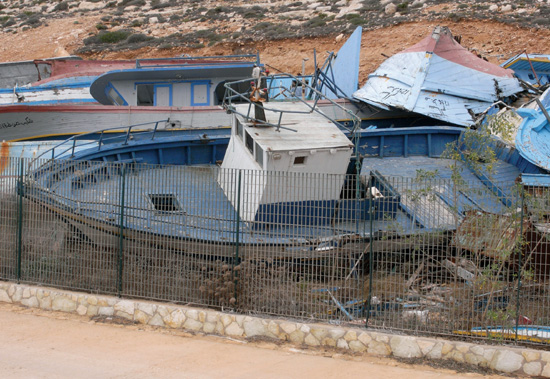
to be continued…
Concept for an art project in the building Normannenstraße 19 in Berlin Lichtenberg, former Ministry for State Security of the GDR
In Normannenstraße 19, an oversized “linoleum section” is being created in the floor covering of the building; two large halls with over 800 m2 PVC floor covering form the starting material for this.
I cut directly into the found substance of this charged place and inscribe myself in it with pictures and words. I break the resistance of his material: the building or its floor is transformed into a huge stamp. A controversial place in contemporary history that has been abandoned for years is revived, reoccupied and redefined.
After the linocut has been produced, it is printed and sewn onto 3-metre-wide lengths of fabric. The site and the artistic intervention will then be made accessible to the public in an exhibition.
The six-week exhibition in Normannenstraße offers the opportunity to present the entire print (approx. 18 metres high and 30 metres wide) on the outer façade and numerous individual prints as well as the entire ground work inside the building. Here visitors can walk over the work of art – the printing block – and the print results hang from the ceiling and on the walls. The viewer finds and moves between “positive” and “negative” – the floor work and its prints become an installation.
It is particularly important to use the floor for this intervention, because it is literally “fundamental” and the starting point for all our activities. Important events, clashes, history – everything inscribes itself sedimentarily here – the ground is a carrier of meaning, in which one has to dig oneself in if one wants to find it.
For me, the process of approaching and working with the soil material symbolizes the handling of the Stasi – an open process to uncover the deposits and sediments.
Definition of content and background
For many years I have been interested in abandoned, functionless buildings as artistic source material: On the one hand, in order to appropriate and occupy the “dead” space beyond the institutional art world and thus open up new play and effect spaces for art. On the other hand, it is the socio-political dimension: the phenomenon of “vacancy” in urban agglomerations is the result of a real estate market increasingly determined by speculation and profit maximization. Intervention in this wasteland resource therefore also has a social dimension and significance. By establishing references to the social function and history of the place, my interventions can be compared with the attempt to reactivate forgotten memory by means of psychoanalysis.
The building Normannenstraße 19 in Berlin Lichtenberg, which had been vacant for about 10 years, was part of the Ministry for State Security of the GDR. Here there was a cinema, canteen and ballroom for the servants and agents as well as shopping facilities in Intershops. A few weeks after the opening of the Wall and the “Wende”, the building was occupied in January 1990 by numerous citizens of the former GDR and searched for files. Hardly any other place in Berlin was more severely rejected or even hated than this one.
The topic of surveillance and punishment inscribed in this place is the starting point and reference point of my intervention.
It is about both a critical examination of the former state security of the GDR and a historical review of various state concepts of surveillance and repression – from the medieval pillory to the Nazi block warden, from grid searches to the digital present, locating people from outer space via GPS and mobile phones.
“Telephone Surveillance, Raster Investigation, Bugging Attack, Government Access to Bank Accounts, Video Surveillance, Data Retention, Secret Searches
private computers, central storage of digitized fingerprints, internal military operations, shooting down hijacked civilian aircraft…” (Heribert Prantl, in Der Terrorist als Gesetzgeber, How to make politics with fear. Verlag Droemer Knaur 2008) – this is the direction in which new initiatives are constantly being taken by politicians under the heading “Fight against international terrorism”. They repeatedly raise the question of the relationship between civil liberties on the one hand and state control on the other. This relationship is increasingly shifted to the detriment of freedoms and in favour of state control. This development and its implicit contradictions are put up for discussion in the project in the sense of an emancipatory discourse and a civil societal confrontation between civil liberties vs. state power – data protection vs. security.
Even if problematic tendencies towards excessive surveillance can be observed, at the same time there are manifold initiatives to infiltrate and question these measures by the authorities. These impulses of resistance should also flow into the work.
In addition, the project explores the extent to which art – in times of dominant market orientation – is able to convey and transport universal contents such as the idea of “freedom” as a current social concept of life.
Promotion
This labour-intensive and complex project requires substantial financial support in order to be realised. It has the potential to be perceived in and beyond Berlin as an important art project and to initiate a social debate among the general public.
Thomas Kilpper
Berlin, April 2008





Fuck your Landlord
Field Work in the Streets of London, 2003
knowing that the lease expires and my landlord is going to rise
the rent (from £700 to £900) I move with a minimal house on wheels
through the streets: the drastic rising rents force to unorthodox
measures.
a (failed) field-test to survive in the public space: one wheel
brakes and the police comes and arranges for the hut to leave the
streets. later on it was on display in the ‘Independance’-show in the
South London Gallery.










Al Hissan – The Jenin Horse
Art in Public Space Under Conditions of Occupation
By invitation of the Goethe Institute Ramallah, I led a several week long workshop with Palestinian youths in Jenin in the summer 2003.
Together we built a 5 meter tall horse out of scrounged metal taken from destroyed houses and cars. The horse was subsequently towed through the streets of Jenin and, at a later point, almost 200 km away through the occupied territories of the West Bank.
